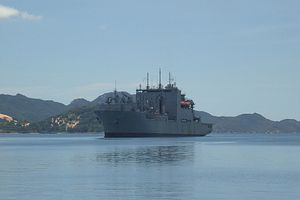The United States is not seeking a base in Vietnam’s Cam Ranh Bay along the South China Sea following the lifting of a decades-old embargo on the Southeast Asian state, U.S. Ambassador to Vietnam Ted Osius clarified at a forum in Washington, D.C. Thursday (See: “Why Obama’s Lifting of the Vietnam Arms Embargo Matters”).
Amid U.S. President Barack Obama’s visit to Vietnam and the full lifting of the embargo, several news outlets had speculated about the future steps in U.S.-Vietnam defense ties. As I indicated in a previous piece for The Diplomat, we could see several moves, including the transfer of equipment, the expansion of port calls, and the visit of U.S. vessels to the newly-opened Cam Ranh Bay International Seaport as Japan, Singapore, India, and France have already done (See: “US-Vietnam Defense Relations: Problems and Prospects”).
However, other reports had suggested that Washington could also seek some kind of presence at the restricted naval base at Cam Ranh Bay, a deep-water harbor in central Vietnam along the South China Sea. Washington had used as a Cam Ranh Baby as a base during the Vietnam War before the then-Soviet Union leased it following the end of the conflict in 1975. A move to establish a U.S. presence there would have been out of step with Vietnam’s traditional omnidirectional foreign policy approach.
Speaking Thursday at the Center for Strategic and International Studies (CSIS), a Washington, D.C.-based think tank, Osius said any suggestion that the United States was seeking either a permanent or rotational presence at the restricted naval base at Cam Ranh Bay had “no basis in reality.”
“There’s been a lot of fulminating in the press about Cam Ranh Bay, and some of the fulminating has no basis in reality. Some of the articles I’ve looked at, I’ve had to wonder what planet people are living on,” he said.
“There is zero expectation that we would have access to that restricted naval base. Zero expectation that we would have a rotating presence in Cam Ranh Bay or a base in Cam Ranh Bay. Zero,” Osius went on to clarify.
But Osius did confirm that in time, U.S. vessels would look to visit the Cam Ranh Bay International Seaport – a fee-for-service facility accessible for any country for services like repairs and refueling – as officials had privately indicated previously (See: “Vietnam Unveils New Port Facility for Foreign Warships in Cam Ranh Bay”).
“I would expect that we would take advantage of that facility… when that facility is more ready than it is right now,” Osius said.
As I have written before, Vietnam marked the completion of the first construction phase of the facility in March. The United States has long signaled its interest in some kind of access for its ships to Cam Ranh Bay, with former U.S. Defense Secretary Leon Panetta mentioning during a historic visit there back in 2012 that this was “a key component” of the U.S.-Vietnam relationship.
Osius added that the timing would be dependent on several factors including the terms for such a visit, the cost, as well as the services available.
Asked separately what Vietnam might seek to buy from the United States following the lifting of the decades-old arms embargo, Osius said that Hanoi would first look to equipment related to maritime security.
“I would imagine that the first items that Vietnam will seek from us will be those that will help it in the realm of maritime security,” he said.
Items that could be on the list include P-3C Orion maritime patrol aircraft as well as equipment to enhance maritime intelligence, surveillance, and reconnaissance (ISR) like radar and drones. It is unclear which of these transactions would constitute full-price sales rather than transfers made through programs such as the U.S. Excess Defense Articles program, indicating used U.S. military items provided to allied and partner countries at reduced or no cost.
Osius said that the United States has already received a couple letters of request from Vietnam on items of interest, and that there may be more coming. However, in line with what U.S. officials have been stressing, Osius said the process of equipment transfer would be a slow, step-by-step process, in part because Vietnam is still seeking to understand U.S. procurement processes (See: “The Case for Lifting the US Vietnam Arms Embargo”).
“Anybody who thinks there will be suddenly be an outpouring of spending is wrong. It’s going to take a while,” he said.
































